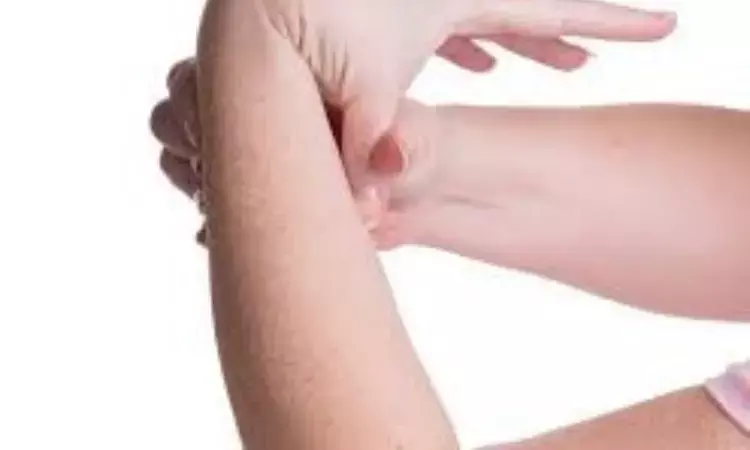- Home
- Medical news & Guidelines
- Anesthesiology
- Cardiology and CTVS
- Critical Care
- Dentistry
- Dermatology
- Diabetes and Endocrinology
- ENT
- Gastroenterology
- Medicine
- Nephrology
- Neurology
- Obstretics-Gynaecology
- Oncology
- Ophthalmology
- Orthopaedics
- Pediatrics-Neonatology
- Psychiatry
- Pulmonology
- Radiology
- Surgery
- Urology
- Laboratory Medicine
- Diet
- Nursing
- Paramedical
- Physiotherapy
- Health news
- Fact Check
- Bone Health Fact Check
- Brain Health Fact Check
- Cancer Related Fact Check
- Child Care Fact Check
- Dental and oral health fact check
- Diabetes and metabolic health fact check
- Diet and Nutrition Fact Check
- Eye and ENT Care Fact Check
- Fitness fact check
- Gut health fact check
- Heart health fact check
- Kidney health fact check
- Medical education fact check
- Men's health fact check
- Respiratory fact check
- Skin and hair care fact check
- Vaccine and Immunization fact check
- Women's health fact check
- AYUSH
- State News
- Andaman and Nicobar Islands
- Andhra Pradesh
- Arunachal Pradesh
- Assam
- Bihar
- Chandigarh
- Chattisgarh
- Dadra and Nagar Haveli
- Daman and Diu
- Delhi
- Goa
- Gujarat
- Haryana
- Himachal Pradesh
- Jammu & Kashmir
- Jharkhand
- Karnataka
- Kerala
- Ladakh
- Lakshadweep
- Madhya Pradesh
- Maharashtra
- Manipur
- Meghalaya
- Mizoram
- Nagaland
- Odisha
- Puducherry
- Punjab
- Rajasthan
- Sikkim
- Tamil Nadu
- Telangana
- Tripura
- Uttar Pradesh
- Uttrakhand
- West Bengal
- Medical Education
- Industry
Endovascular aortic repairs bring comparable to open aortic surgery in patients with connective tissue disease: JAMA

Sweden: A cohort study of patients with connective tissue disease (CTD) revealed that those who underwent endovascular aortic repairs, including redo procedures and complex repairs of the visceral aorta and aortic arch, had midterm survival comparable with reports of open aortic surgery.
Additionally, the rate of secondary procedures was found to be high, but few patients required conversion to open repair.
"Improvements in techniques and devices and ongoing follow-up may lead guideline recommendations to include endovascular treatment for patients with connective tissue disease, the researchers reported in their study published in JAMA Surgery.
Endovascular treatment is not recommended for aortic pathologies in patients with connective tissue diseases other than in redo operations and bridging procedures in emergencies. However, this dogma may be challenged by the recent developments in endovascular technology. Karl Wilhelm Olsson, Department of Surgical Sciences, Uppsala University, Uppsala, Sweden, and colleagues aimed to assess the midterm outcomes of endovascular aortic repair in patients with connective tissue disease in a descriptive retrospective study.
For this purpose, the researchers collected data on interventions, demographics, and midterm and short-term outcomes from 18 aortic centres in New Zealand, North America, Asia, and Europe. The study included CTD patients undergoing endovascular aortic repair from 2005 to 2020. A total of 171 patients were included: 142 with Marfan syndrome, 17 with Loeys-Dietz syndrome, and 12 with vascular Ehlers-Danlos syndrome (vEDS). The median age was 49.9 years, and 62.6% of patients were male.
The primary outcomes of the study were short-term and midterm survival, conversion to open repair, and rates of secondary procedures.
The study led to the following findings:
- 88.9% of patients were treated for aortic dissections and 11.1% for degenerative aneurysms. 79.5% had undergone open aortic surgery before the index endovascular repair.
- In 43.3% of patients, arch and visceral branches were included in the repair.
- Primary technical success was achieved in 168 patients (98.2%), and 30-day mortality was 2.9%.
- Survival at 1 and 5 years was 96.2% and 80.6% for Marfan syndrome, 93.8% and 85.2% for Loeys-Dietz syndrome, and 75.0% and 43.8% for vEDS, respectively.
- After a median follow-up of 4.7 years, 53.2% of patients had undergone secondary procedures, of which 8.2% were open conversions.
"Our findings showed that endovascular aortic interventions in patients with CTD had low perioperative mortality, a high rate of early technical success and a midterm survival rate comparable with reports of open aortic surgery in CTD patients," the researchers wrote. "We observed a high rate of secondary procedures, but few patients required conversion to open repair."
"Improvements in techniques and devices and ongoing follow-up may lead to endovascular treatment for patients with CTD being included in guideline recommendations," they concluded.
Reference:
Olsson KW, Mani K, Burdess A, et al. Outcomes After Endovascular Aortic Intervention in Patients With Connective Tissue Disease. JAMA Surg. Published online June 14, 2023. doi:10.1001/jamasurg.2023.2128
Dr Kamal Kant Kohli-MBBS, DTCD- a chest specialist with more than 30 years of practice and a flair for writing clinical articles, Dr Kamal Kant Kohli joined Medical Dialogues as a Chief Editor of Medical News. Besides writing articles, as an editor, he proofreads and verifies all the medical content published on Medical Dialogues including those coming from journals, studies,medical conferences,guidelines etc. Email: drkohli@medicaldialogues.in. Contact no. 011-43720751


